Coordinación
Una coordinación sólida puede evitar vacíos y duplicaciones en las respuestas humanitarias, así como garantizar que los PTM complementen otros tipos de asistencia. Sin embargo, el informe del «Estado Global de los Programas de Transferencias Monetarias» de la CALP Network muestra que la coordinación de la asistencia en efectivo es vista como débil y ad hoc, y que esto está teniendo graves repercusiones operativas.
Los donantes, las ONG y los líderes de los grupos de trabajo de transferencias monetarias (GTM) han pedido claridad sobre tres temas principales relacionados con la coordinación de la asistencia en efectivo:
- Quién debe ser responsable de asegurar una coordinación eficaz de la asistencia en efectivo;
- Cuál es la función y el mandato de los grupos de trabajo de transferencias monetarias, incluso en relación con las transferencias monetarias multipropósito;
- Cómo se debe dotar de recursos a la coordinación de asistencia en efectivo.
Tenemos que basarnos urgentemente en lo que funciona y proporcionar claridad a nivel mundial sobre las preguntas arriba mencionadas, adaptándonos a los diferentes contextos. Hace mucho tiempo que se deberían haber tomado decisiones claras basadas en necesidades operativas y no en la política de las agencias.
Prioridades actuales
El objetivo de la CALP Network es contribuir a seguir progresando en este tema en tres niveles: apoyar a los grupos de trabajo de transferencias monetarias a nivel regional; contribuir a soluciones prácticas para la coordinación de la asistencia en efectivo a nivel mundial; y convocar una discusión basada en la evidencia sobre temas clave, destacando puntos de decisión críticos y oportunidades de progreso.
Contenido destacado
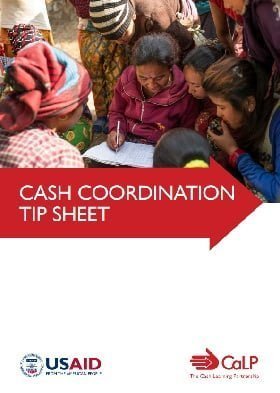
Cash Coordination Tip Sheet
Guidelines and Tools
This tip sheet sets out established best practice, key guidance and resources for all aspects of cash coordination, intended as a clear, accessible and action-oriented guide for those engaged in coordination of cash and voucher assistance (CVA) at the field level.
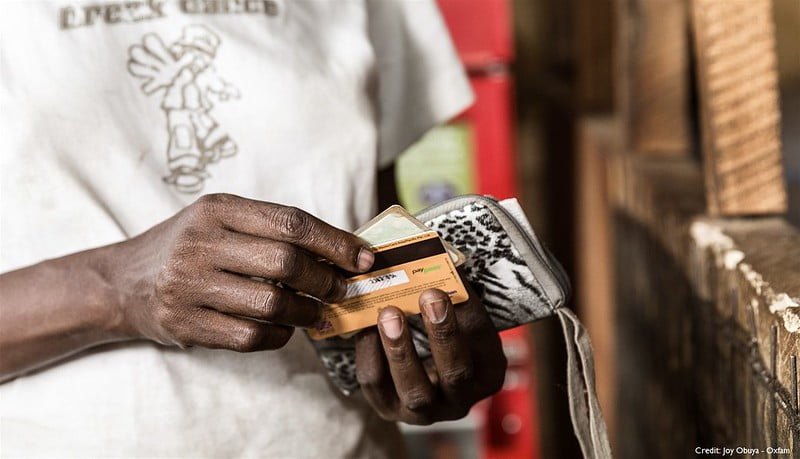
Introducing the Cash Coordination Tip Sheet
Webinar
The CALP Network has developed a tipsheet setting out established best practice and key guidance and resources for all aspects of cash coordination, intended as a clear, accessible and action-oriented guide for those engaged in coordination of cash and voucher assistance at the field level.

Cash Coordination: A proposal from members in MENA
Blog Post
Earlier this year the CALP Network undertook regional consultations to explore options for cash coordination. This blog lays out recommendations from participants from the Middle East and North Africa who sketched out what cash coordination, and coordination more broadly, could look like in future to support a more effective, efficient and accountable response.
Últimos recursos

Case Study: Documentation of experiences using CVA for nutrition outcomes in Nigeria
Case Study
This case study was conducted as part of the wider initiative to develop guidance on the use of cash and voucher assistance (CVA) for nutrition outcomes. The case study reflects experiences and lessons learned in the context of Nigeria. It further explores opportunities to improve the nutrition...
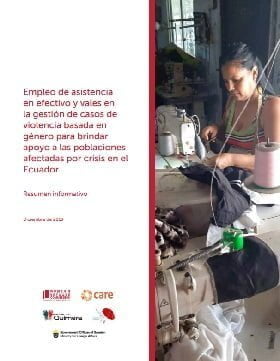
Empleo de asistencia en efectivo y vales en la gestión de casos de violencia basada en género para brindar apoyo a las poblaciones afectadas por crisis en el Ecuador
Informe
Con el respaldo del Ministerio de Asuntos Exteriores de Suecia, la Comisión de Mujeres Refugiadas y CARE se asociaron para impulsar la Hoja de Ruta del Llamado a la Acción mediante el refuerzo de la capacidad de los proveedores de servicios relacionados con la violencia basada en género y la asistencia...

COVID-19: A chance to empower citizens through social protection
Report
Billions of US$ are now being distributed to citizens by governments to stave off deteriorating economic impact and rising poverty from COVID-19. The unprecedented pandemic demands an unprecedented government response. More than 126 countries have already introduced or adapted social protection or labour...

Public health and social measures for Covid19 prepardness and response in low capcity and humanitarian context
Guidelines and Tools

CVA and COVID19 TipSheet
Guidelines and Tools
While the Gaza Strip has not experienced a violent outbreak of COVID19 cases, secondary and indirect effects of the measures necessary to prevent the spread of the virus have impacted the regular humanitarian work implemented in the area.
This note aims at collecting learning, practices and initiatives...

COVID-19: Safe distribution of food, cash and non-food items
Guidelines and Tools
This guide discusses how to adapt and run food, cash and non-food item (NFI) distribution sites in the context of COVID-19.

Humanitarian Impact of Covid-19 in West and Central Africa
Policy paper
Produced by the Regional Inter-Sector Coordination Group for Humanitarian Affairs in West and Central Africa (R-ISCG), this document summarises the main impacts of Covid-19 on the population of the region and on ongoing humanitarian operations. The R-ISCG also wishes to put forward some key...
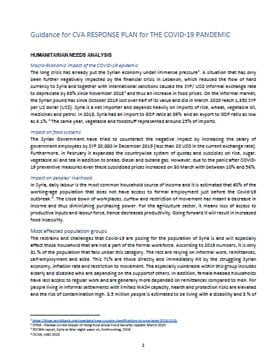
Guidance for CVA Response Plan for The COVID-19 Pandemic
Guidelines and Tools
This document from the Damascus CWG provides guidance intended for CVA practitioners preparing a response plan for COVID-19. It includes a sections on humanitarian needs analysis, response approach, coordination mechanisms.

Midiendo los Resultados de la Asistencia en Efectivo: Un reto y a la vez una necesidad
Blog Post
Los programas de transferencias monetarias multipropósito en el punto de mira, también en tiempos del COVID-19. La fase de recogida de información para el Informe global sobre la situación de los Programas de Transferencias Monetarias (PTM), en su segunda edición, y cuya publicación está prevista...

CCD Ethiopia one-year in: Collaboration in reality
Report
Based on insights compiled from surveys and interviews conducted with members of the Ethiopian cash community and CCD (Collaborative Cash Delivery Network) members in January 2020, this report provides an overview of how CCD Ethiopia is working towards global and national objectives, takeaways for startup...

Cash Transfers and Cash Plus Interventions in Yemen since 2015: An Annotated Bibliography
Report
This report presents an annotated bibliography of cash transfers and cash plus interventions that have been instituted in Yemen’s humanitarian and development sectors since 2015. Before the outbreak of conflict in Yemen in 2015, the Social Welfare Fund (SWF) was the country’s flagship social...

Why is tracking CVA considered a challenge, and will applying minimum requirements help to make progress?
Blog Post
How much humanitarian aid is delivered as cash and voucher assistance (CVA)? An innocent enough enquiry, which may not have quite opened Pandora’s box, but has released a few cans of worms. This is a very technical topic and has a lot to do with the complexities and limitations of organizational and...

Behavioral Design Checklist for Humanitarian Cash and Voucher Assistance Improving Outcomes for Women
Guidelines and Tools
This checklist highlights designs for humanitarian cash and voucher assistance (CVA) that can increase the impact
of CVA for women recipients in the Middle East and North Africa (MENA) region. The goal of the design principles presented is to optimize CVA to help recipients effectively spend the transfer...

Applying Behavioral Science to Humanitarian Cash camp; Voucher Assistance for Better Outcomes for Women
Report
Cash and voucher assistance (CVA) is widely recognized as an effective and powerful tool in humanitarian settings. Recent innovation in humanitarian CVA has sought to increase efficiency by harmonizing procedures and improving delivery through new technology; these
innovations have cut costs while...
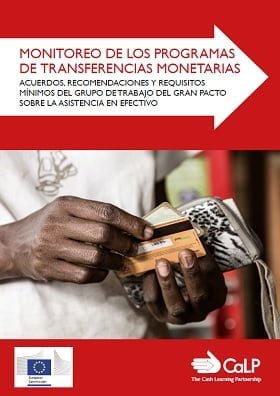
Monitoreo de los Programas de Transferencias Monetarias: acuerdos, recomendaciones y requisitos mínimos del grupo de trabajo del Gran Pacto sobre la asistencia en efectivo
Guía y herramientas
Este documento agrupa los principales resultados del trabajo realizado por el Grupo de Trabajo para el Monitoreo de los Programas de Transferencias Monetarias (PTM) entre 2017 y 2019. El Grupo de Trabajo sobre Monitoreo de PTM se estableció como la plataforma para lograr compromiso y toma de decisiones...

Global Education Cluster Note on the use of CVA for EiE in COVID-19 context
Policy paper
Guidance document on the use of CVA for Education in Emergencies in COVID-19 contexts. This note is intended to provide additional insights for education clustercoordinators on the potential uses of CVA for EiE in the current COVID-19 pandemic response under the GHRP COVID-19
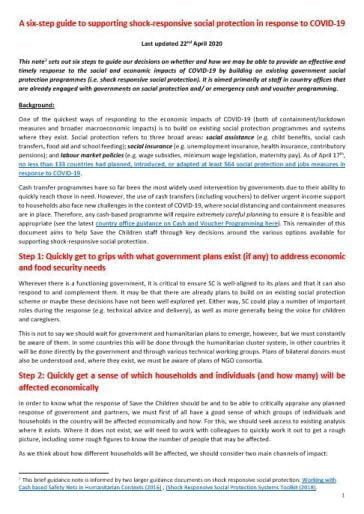
A six-step guide to supporting shock-responsive social protection in response to COVID-19
Guidelines and Tools
This note[1] sets out six steps to guide our decisions on whether and how we may be able to provide an effective and timely response to the social and economic impacts of COVID-19 by building on existing government social protection programmes (i.e. shock responsive social protection). It is aimed...

Lessons learned and Opportunities: Linking SP systems to humanitarian cash in a pandemic
Webinar

Cash as a core component of the COVID-19 Response in Iraq
Policy paper
The COVID-19 pandemic and the containment measures imposed to limit transmission have both severe immediate and long-term economic consequences. The globe is experiencing ‘one of the sharpest economic contractions in modern times.’ As always in a time of crisis, it is the
most vulnerable that will...

External Evaluation of SDC/HA Emergency Cash Pilot For Earthquake Affected Households in Bubq, Albania
Report
In November 2019, Albania was hit by a large earthquake with a magnitude of 6.4, causing 51 people to lose their lives and injuring 913 people. Around 47,000 additional people were directly affected by the earthquake. The Swiss Agency for Development and Cooperation (SDC) immediately deployed a rapid...